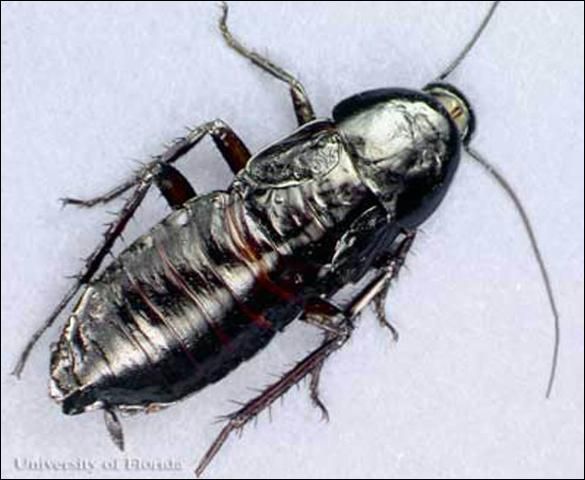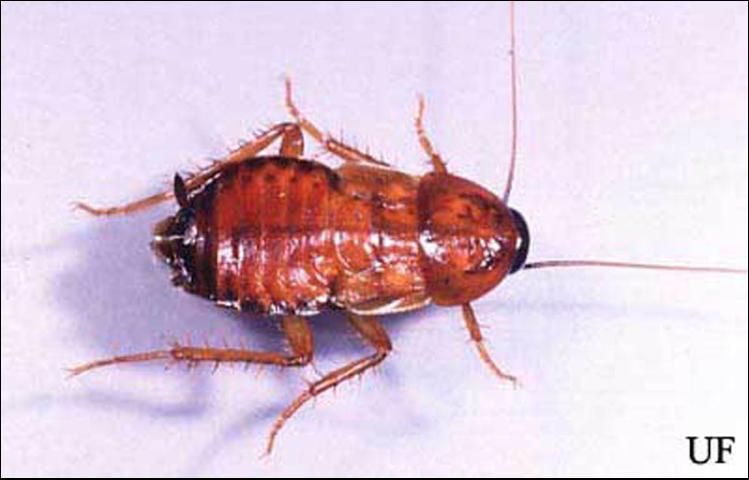The Featured Creatures collection provides in-depth profiles of insects, nematodes, arachnids and other organisms relevant to Florida. These profiles are intended for the use of interested laypersons with some knowledge of biology as well as academic audiences.
Introduction
The origin of the oriental cockroach, Blatta orientalis Linnaeus, is uncertain, but it is thought to be from Africa or south Russia. It is a major household pest in parts of the northwest, midwest, and southern United States. It is also sometimes referred to as the "black beetle" or a "water bug" because of its dark black appearance and tendency to harbor in damp locations.
Description
The oriental cockroach is approximately 1 inch long (22 to 27 mm) and dark brown to black. Males have wings covering 3/4 of their body, and the female has very short (rudimentary) wings. The inner wing folds like a fan and is membranous. The outer part of the wing is narrow, leathery and thick. The styli between a pair of jointed cerci can identify the male. Both the male and female are flightless.

Credit: Rebecca W. Baldwin, UF/IFAS

Credit: Rebecca W. Baldwin, UF/IFAS
Life Cycle
A female oriental cockroach produces an average of eight egg capsules per lifetime. Each egg capsule or ootheca contains about 16 eggs that are lined up vertically, two by two in the egg case. The egg capsule may be carried from 12 hours to five days and then deposited in a warm sheltered environment where food is readily available. The incubation period for the oriental cockroach is about 42 to 81 days. The female gives no assistance to the young. Nymphs go through seven molts before becoming adults, which takes approximately one year. An adult Blatta orientalis can live from 34 to 180 days, and pairing takes place at any season.

Credit: Paul M. Choate, UF/IFAS

Credit: Paul M. Choate, UF/IFAS
Detection
Any area that has a high humidity and a cool temperature should be examined. Crawl spaces, basements, and kitchen and bathroom plumbing can be inspected for dead roaches, egg cases, and fecal smears. Also, any spider webs in these locations can be inspected for cockroach remains.
Habits and Habitat
Blatta orientalis is common outdoors and lives in warm, damp, shady areas near the ground or any area containing natural debris. It will often seek refuge indoors when a drop in temperature occurs but is still quite tolerable of cooler weather. The most common areas to find Blatta orientalis are basements, crawl spaces, areas between the soil and foundation, underneath sidewalks, in sewer pipes, in floor drains, and under sinks or any other damp, cool area in the house. The roach travels through the structure on plumbing pipes. Outside the house they sometimes aggregate near or under garbage cans. The species tends to be seasonal, with adults appearing in spring and summer. When large numbers of roaches occur, overcrowding can lead to the mass migration of roach species such as the German cockroach, Blattella germanica, the American cockroach, Periplaneta americana, and the oriental cockroach.
Diet
The oriental cockroach is often found feeding on garbage, sewage, or decaying organic matter and will eat almost anything. A diet high in starch is preferred.
Management
Blatta orientalis often deposits oothecae in cracks and crevices that can be very difficult to treat with insecticides; or by the time the nymphs hatch from the oothecae the application is degraded or removed. Therefore new methods are being developed to manage the roach in combination with regular sprays and dusts. There has been an increased interest in recent years to use juvenile hormone analogues (JHAs) for the control of many insect pests. JHAs have a low vertebrate toxicity, a highly specific biological action, and the ability to disrupt growth and reproduction in insects, which makes JHAs a good candidate for use in domestic and public environments.
A chemical barrier around the perimeter of the home along with insecticides applied to specific locations inside will help control Blatta orientalis. However, rapid breakdown of the insecticides can occur because oriental cockroaches prefer to rest on damp surfaces. The following are some other tips that can help the management of Blatta orientalis in and around the home.
- The outsides of doors, windows, pipe openings and dryer vents should be treated with a good residual spray.
- Any plumbing leaks should be fixed, and any moist spaces should be ventilated.
- Cracks in the structure should be caulked at ground level.
- Decaying leaves and organic matter should be removed from windows and doors.
- Garbage cans should be kept out of moist habitats.
- Drain traps should be kept full or capped.
For further information, see Cockroaches and Their Management (https://edis.ifas.ufl.edu/IG082).
Selected References
Appel AG. 1997. Nonchemical approaches to cockroach control. Journal of Economic Entomology 14: 271–280.
Baldwin RW, Fasulo TR. (2005). Cockroaches. UF/IFAS CD-ROM. SW 184. (03 July 2014)
Edwards JP, Short JE. 1993. Elimination of population of the oriental cockroach (Dictyoptera: Blattidae) in a simulated domestic environment with the insect hormone analogue (S)-Hydroprene. Journal of Economic Entomology 86: 436–443.
Fasulo TR, Kern WH, Koehler PG, Short DE. 2005. Pests In and Around the Home. UF/IFAS. SW-126. (03 July 2014)
Fasulo TR, Koehler PG. 2002. Cockroaches and Pest Ants—Computer-verified Training Tutorials. Bug Tutorials. UF/IFAS. SW-157. http://entomology.ifas.ufl.edu/fasulo/pests/software/det_bugs.htm (03 July 2014) (no longer available online)
Hagenbuch BE, Koehler PG, Patterson RS, Brenner RJ. 1988. Peridomestic cockroaches (Orthoptera: Blattidae) of Florida: their species composition and suppression. Journal of Medical Entomology 25: 377–380.
Suiter DR, Koehler PG. (1991). Oriental cockroach, Blattella orientalis. UF/IFAS. ENY-239. (no longer available online)
Thoms EM, Robinson WH. 1986. Distribution, seasonal abundance, and pest status of the oriental cockroah (Orthoptera: Blattidae) and an evaniid wasp (Hymenoptera: Evaniidae) in urban apartments. Journal of Economic Entomology 79: 431–436.
Thoms EM, Robinson WH. 1987. Distribution and movement of the oriental cockroach (Orthoptera: Blattidae) around apartment buildings. Journal of Environmental Entomology 16: 731–737.
Thoms EM, Robinson WH. 1987. Insecticide and structural modifications strategies for management of oriental cockroach (Orthoptera: Blattidae) populations. Journal of Economic Entomology 80: 131–135.